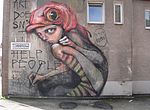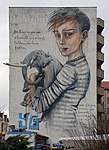Herakut
Herakut is a German artist duo from the street art scene , consisting of Jasmin Siddiqui and Falk Lehmann. They have been internationally active since 2004 and, among other things, create murals in public spaces.
life and career
Both Siddiqui and Lehmann were already active in the field of street art before their meeting and the fusion of their talents .
Jasmin Siddiqui was born in Frankfurt am Main in 1981 as the daughter of a Pakistani and a German. Because of her origins, she often had to struggle with prejudices, especially when she was at school, many classmates reduced her to her skin color. Out of frustration and dissatisfaction with this pigeonhole thinking, she began to create graffiti and thus created her own world. In addition, Siddiqui showed great enthusiasm for the graffiti artists who decorated the gray and dreary walls of the city with color. Following the wishes of her parents, she began studying communication design. However, she quickly realized that this did not represent a future for her. Instead, she felt at home in the graffiti scene, which she became active in in her early twenties. Hera , the name of the Greek goddess, became Siddiqui's pseudonym and stage name from then on. It represents the contrast and transformation from the once shy and reserved to the strong and self-confident woman that she embodies today in the male domain.
Falk Lehmann was born in 1977 in Schmalkalden , Thuringia . At the age of 14, Lehmann's interest in the graffiti scene was aroused and he has been painting under the pseudonym Akut since 1994. After graduating from high school, Lehmann first studied architecture at the University of Applied Sciences in Erfurt, but switched to visual communication at the Bauhaus University in Weimar after completing his intermediate diploma . Before working with Siddiqui, Lehmann had been active with his graffiti crew "Ma'Claim" since 2001. The group - consisting of "Akut", "Case", "Rusk" and " Tasso " - had made a name for itself in the scene with a hyper-realistic style that had not yet been widely used in Germany.
In 2004 Siddiqui and Lehmann met at an urban art festival in Spain. After designing a wall together, the two artists decided to combine their talent and their names. Hera and Akut were now Herakut. Since then, the duo has worked closely together and developed a close friendship.
For several weeks a year, Siddiqui and Lehmann travel around the world to find new places and locations for their works. In February 2014 they were invited by the AptART organization to travel to the Zaatari refugee camp in Jordan for three weeks, to transform the white containers and walls of the camp into colorful paintings with Syrian children. Initially, only three murals were planned. Ultimately, with the help of the children, a total of eight murals were created. In the “Colors Of Resilience” exhibition in Frankfurt-Sachsenhausen you could see the results of the work in Jordan on photos, sketches and canvases.
Herakut is highly regarded internationally, and Jim Carrey commissioned the artist duo to paint his house.
For a while, the duo used Lehmann's parents' house in the Thuringian Forest as a studio. They have been living and working in Berlin since 2015.
Motifs and design
The spectrum of Herakut's work ranges from small collages, elaborate installations and canvas works to huge murals on house facades. Figures and faces, mostly mythical creatures made of humans and animals, adorn buildings all over the world. The big eyes with their melancholy expression are particularly eye-catching.
Due to their different artistic styles, Hera and Akut each have different tasks in the context of their collaboration: while Siddiqui is responsible for the rough outlines, Lehmann takes care of the fine-tuning. For the rough version, Hera mainly uses brushes and paint rollers, Akut, on the other hand, works out the photo-realistic features of the figures exclusively with the spray can.
Herakut's personal handwriting always includes a poetic saying, which on the one hand provides information about the personality of the character portrayed, but on the other hand is also intended to encourage reflection on general socially and socially critical topics. In addition, the short texts are translated into different languages, depending on the country in which the mural is located. This is how the messages should be understood by as many people as possible.
" Monkey see, Monkey do " ( Berlin, Alt-Stralau)
" As long ase you are standing .. " ( Berlin, Moabit)
" My home might be no palace .. ", 2018, Luckauer Strasse 14, Berlin-Kreuzberg
" See me ", 2019, Lewishamstrasse 15, Berlin-Charlottenburg
intention
Even if some of her works can be found in art galleries as part of exhibitions, urban space is and will remain her preferred exhibition location.
First and foremost, the artists aim to inspire the viewer with their fairy-tale characters and to inspire their imagination. Herakut's pictures often appear very dreary and gloomy. Her wall paintings are supposed to take on the function of a mirror that unadulterated the not always colorful reality.
In addition, both Siddiqui and Lehmann share the view “There is something better than perfection”. This is also the inscription of one of her works on a Frankfurt house facade, which shows a mother with her child. They wear a shiny gold mask on their heads, symbolizing their perfect existence. Perfection is not the measure of all things, instead values such as mercy, benevolence or charity are essential components of our lives. Street art and the work of Herakut are by no means evidence of perfection. There is no right or wrong that is conveyed directly through their art.
The Giant Storybook project
The Giant Storybook describes Herakut's largest and most complex project to date. You want to design, publish and publish a children's book. The artist duo has been traveling around the world since September 2012, spraying house walls, walls and facades, which will later make up the content of their storybook. The result of this project should be a story that cannot be found in one location, but can be read and discovered by people all over the world. A project with a cross-border history.
The main characters of the storybook represent two siblings, the little girl Lily and her brother Jay, who grow up in different worlds. While Jay is trapped in a world of perfection and starts a rebellion by creating graffiti, Lily finds herself in a parallel world of her brother. She doesn't feel comfortable there either and flees to find Jay. Even when the basic framework is in place, the story of the storybook and its characters continue to develop with each page and each mural. The reactions of people on the street are an essential part of this. Depending on how the external image turns out, Herakut also change the meaning of an individual mural or a figure in the context of the story afterwards.
With their storybook, Herakut would like to convey that there are “topics and ideas that concern and connect everyone in the world, regardless of their home country and living conditions”. Instead of always looking for differences, people should rather focus on what they have in common.
literature
Herakut: The perfect merge. Publication, Mainaschaff 2008, ISBN 978-3-939566-24-3 .
Web links
Individual evidence
- ↑ a b c d info - HERAKUT. Accessed March 15, 2018 .
- ↑ Falk Lehmann, Steffen Petermann: Ma'Claim: finest photorealistic graffiti . Publication, Mainaschaff 2006, ISBN 978-3-939566-01-4 .
- ↑ Herakut: The perfect merge . Publikat, Mainaschaff 2008, ISBN 978-3-939566-24-3 , p. 200 .
- ↑ a b c Katharina Schol, Frankfurt: Graffiti artist "Herakut": Encourage courage with color . In: FAZ.NET . June 17, 2014, ISSN 0174-4909 ( faz.net [accessed December 8, 2017]).
- ↑ Herakut in Jordan | street art united states. Retrieved March 15, 2018 (American English).
- ↑ Herakut & aptART: Painting for Peace in Syria | ARTE Creative. (No longer available online.) Formerly in the original ; accessed on December 8, 2017 . ( Page no longer available , search in web archives ) Info: The link was automatically marked as defective. Please check the link according to the instructions and then remove this notice.
- ^ Claudia Henzler: Mannheim: Can graffiti save a city image? Retrieved July 25, 2020 .
- ↑ a b Gallery Kronsbein. Retrieved December 8, 2017 .
- ↑ Two Berlin sprayers beautify the world . ( bz-berlin.de [accessed December 8, 2017]).
- ↑ Silvia Perdoni: Street Art: The Museum for the Spray Can . In: Berliner-Kurier.de . ( berliner-kurier.de [accessed on March 15, 2018]).
- ↑ Herakut . In: URBAN-ART & LIFE-STYLE . August 12, 2016 ( i-love-urbanart.com [accessed December 8, 2017]).
- ↑ Johannes Hollmann, Janina Rathelbeck: You'll be amazed ... Accessed December 8, 2017 (English).
- ↑ DW German: The German graffiti duo Herakut | Euromaxx - Atelier Street. September 14, 2013, accessed December 8, 2017 .
- ↑ Herakut Mural in Mannheim - The Giant Storybook Project . In: City.Wall.Art . July 2, 2014 ( stadt-wand-kunst.de [accessed December 8, 2017]).
- ↑ a b c A graffiti fairy tale conquers the world . In: BRIGITTE . November 5, 2013 ( brigitte.de [accessed December 8, 2017]).
- ^ A b Deutsche Welle: Street art project "Giant Storybook". October 2, 2013, accessed December 8, 2017 .
- ↑ Herakut: "For the triumph of evil it is enough if the good do nothing." In: ZEITJUNG . December 1, 2015 ( zeitjung.de [accessed December 8, 2017]).





